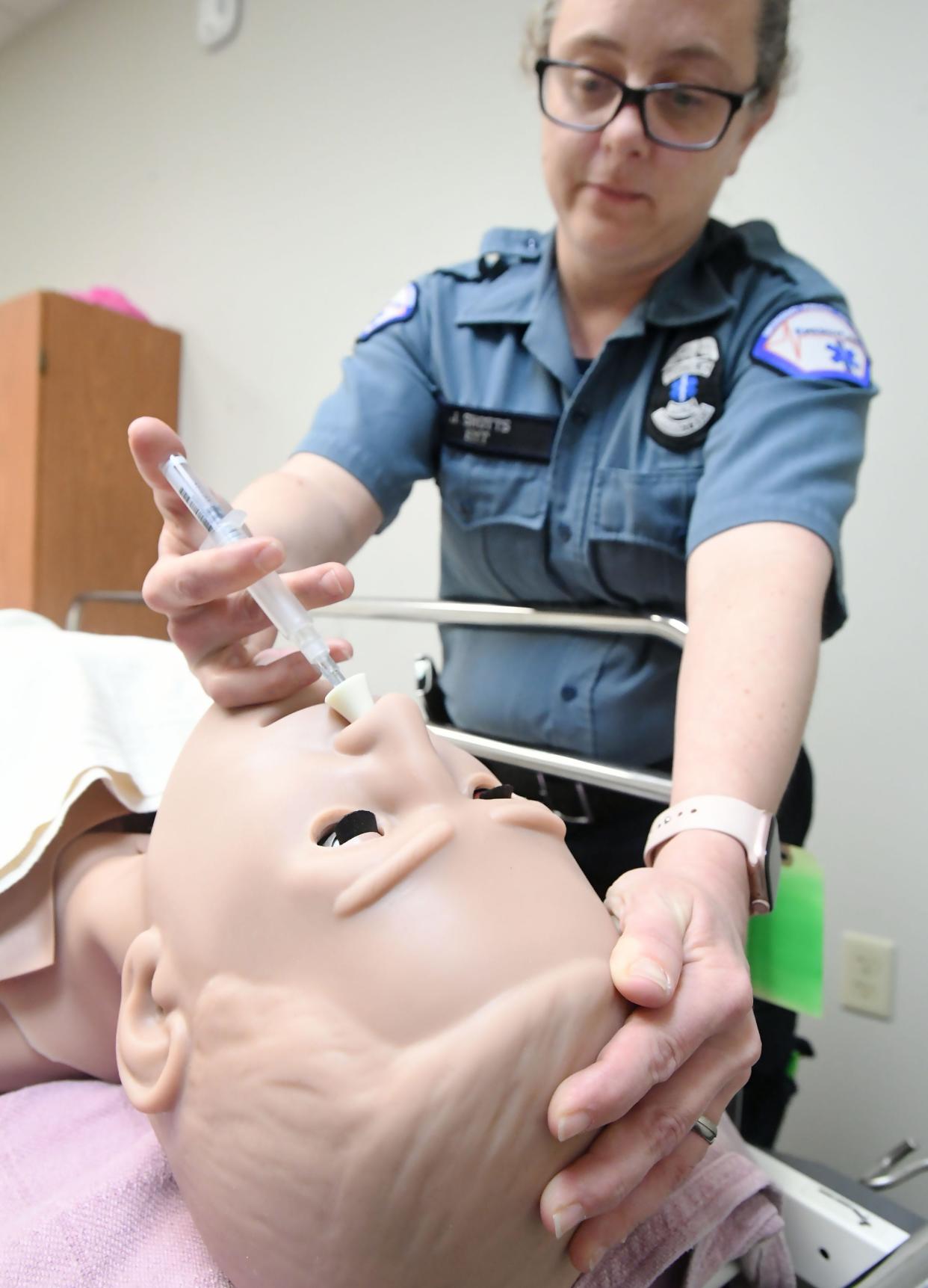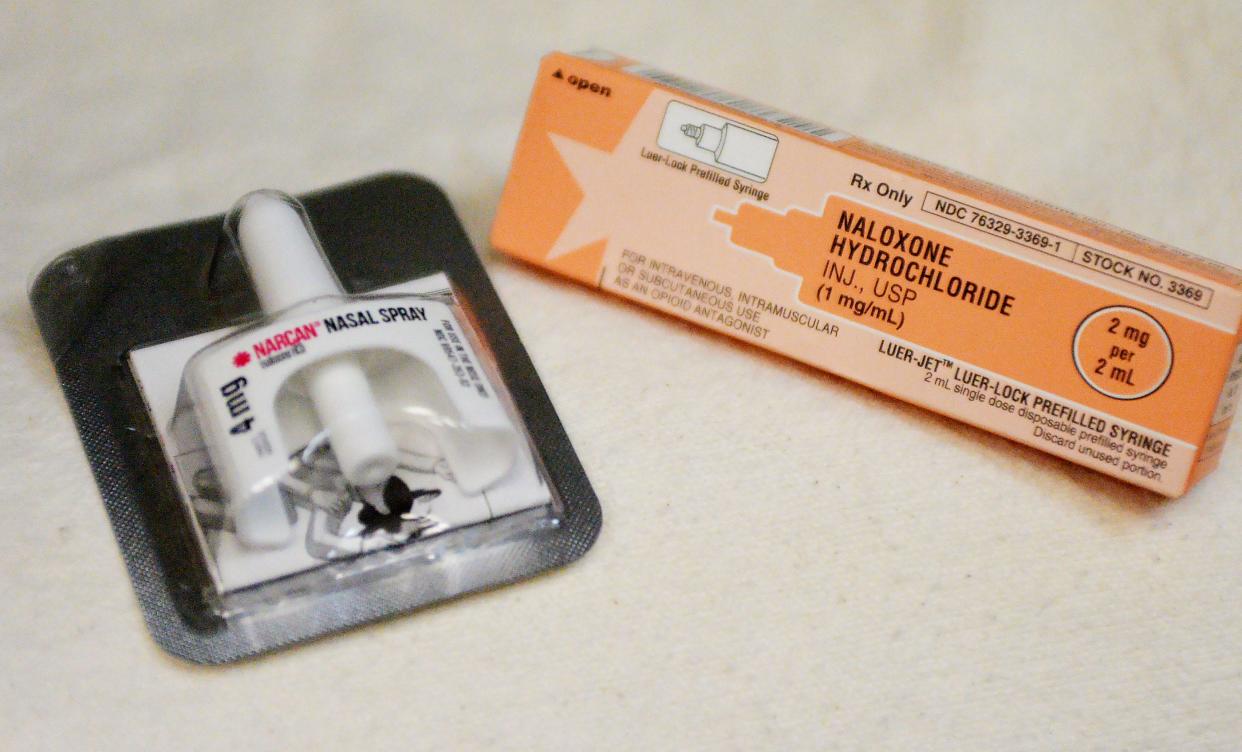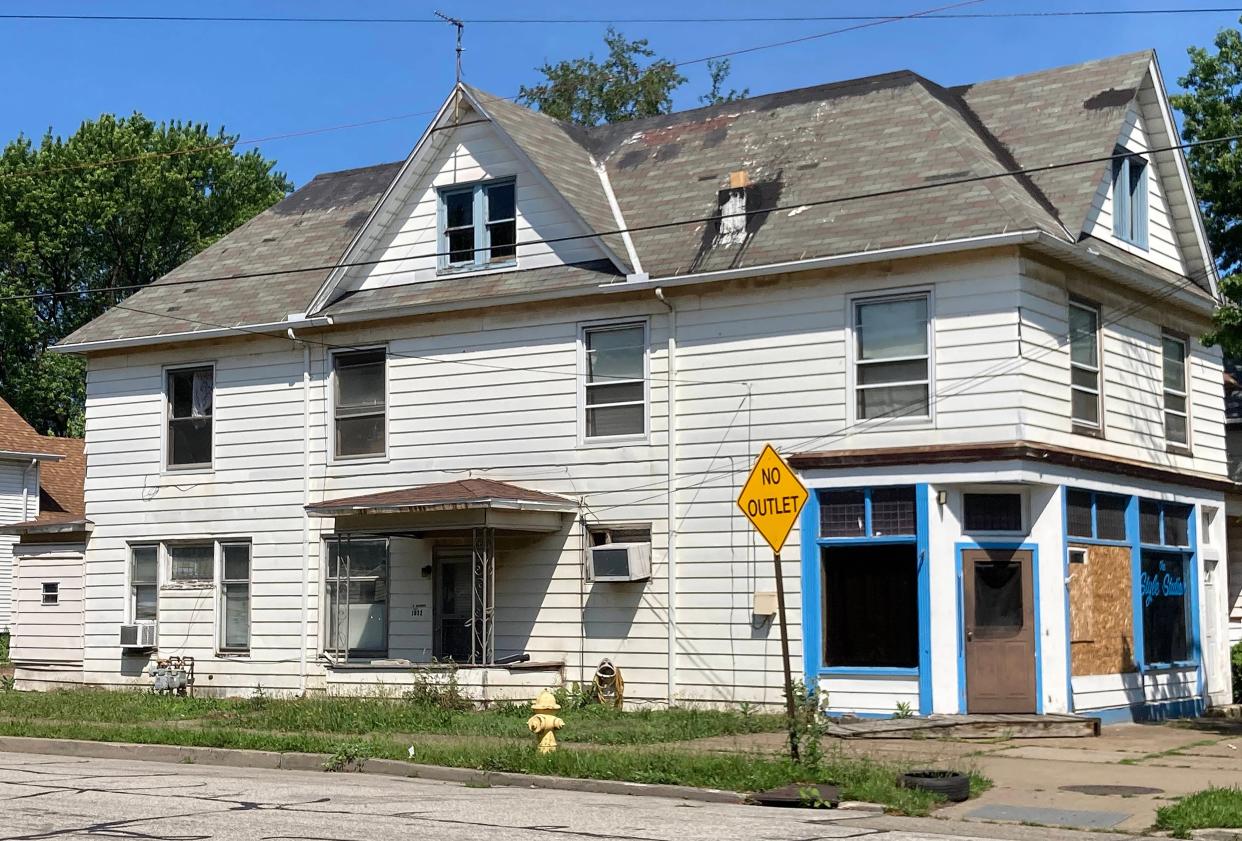New law exposes extent of Pa.'s drug overdose problem, but issues still remain
A new law has helped Pennsylvania capture one of the clearest and bleakest pictures yet of the drug overdose epidemic.
And officials still don't believe they're seeing the full scope of the problem
Act 158 of 2022, also known as the Overdose Mapping Act, required law enforcement officers for the first time to report any encounter they had with a person who accidentally overdosed on drugs to the state's Overdose Information Network (ODIN) within three days of the incident. The database includes both fatal and non-fatal known or suspected overdoses.
The result was a nearly 62% increase in the number of reported overdoses year over year, or 4,703 overdoses in 2022 to 7,634 in 2023.

But not all police agencies are reporting their data within the 72-hour window, and data from the state's emergency medical service providers is not yet included in the database.
"It might take three years or more before we see close to uniform reporting," said Jerry Daley, executive director of the Liberty Mid-Atlantic High Intensity Drug Trafficking Area, a collaborative program that aims to reduce drug trafficking and substance abuse in the Philadelphia area.
Officials from the Center for Rural Pennsylvania compiled the data from ODIN to determine the overdose rates for the state and each of its 67 counties. Across the state, 59 people for every 100,000 overdosed on drugs in 2023, an average of 21 people each day.
"At the state level, we've been examining, investigating, exploring substance use disorder for more than a decade," said Kyle Kopko, the executive director of the Center for Rural Pennsylvania, a research arm of the General Assembly. "This is a protracted problem that's clearly not going away. There's still a lot more work that needs to be done across the board. This is a continued public health emergency."

Pennsylvania State Police and the Liberty Mid-Atlantic High Intensity Drug Trafficking Area formed the Overdose Information Network in 2018, but reporting was voluntary until Act 158 took effect in 2023.
The database, which is connected to a national repository, captures 80 pieces of data about an overdose and allows law enforcement to spot overdose trends, detect spikes in overdoses in specific areas and identify areas where resources, such as the overdose-reversal drug naloxone, are needed.
To understand just how much overdoses in general were being underreported to the Overdose Information Network both before and after the change in law, look at Philadelphia, the state's most populous city and county with more than 1.5 million people. It has numerous law enforcement and emergency response agencies, Daley said, but individual officers do not report data to ODIN. Instead, the information is relayed to ODIN through computer software that is supposed to extract overdose information from police reports, Daley said. That's not happening the way officials intended.
"It's an IT issue," he said.
Consider this: More than 400 overdoses, both fatal and non-fatal, were reported to ODIN in 2022. However, the Philadelphia Department of Public Health in October reported that it had recorded 1,413 drug overdose deaths alone in 2022.
Even after Act 158 took effect, Philadelphia County's overdose rate changed little.
Daley noted that the county had reported only two fatal overdoses through the first week of April.
"We know that's bogus," he said.
New Pa. overdose legislation for EMS providers
State Sen. Doug Mastriano, R-33rd Dist., the primary sponsor of Act 158 of 2022, is now backing legislation that would require EMS providers to report overdose data to ODIN. The Senate unanimously approved S.B. 1054 March 20. It's now in the House for consideration.
In the sponsorship memo, Mastriano said EMS providers handle more than 80% of all overdose calls and that requiring them to report to ODIN would "drastically improve" the system.
“When EMS personnel encounter an overdose, that information doesn’t automatically go into the statewide tracking system,” Mastriano said in a statement after the Senate vote. “I want to close this gap in the data collected by the overdose mapping system so healthcare professionals and law enforcement personnel have access to the best available information.”
State police and the Liberty Mid-Atlantic HIDTA recommended the inclusion of EMS providers. Daley noted "very few are under that one umbrella" of a local government. Most are volunteer organizations, or for-profit outfits contracted to work in different jurisdictions, rather than paid, full-time departments more common in larger cities.
"The ability to track the frequency and relative density of overdose events, whether fatal or non-fatal, in a jurisdiction is really difficult to do without EMS participation," Daley said. "In some parts of the state, it will only be EMS responding. In other parts of the state, police may respond with EMS, but as soon as EMS is on scene the police may leave unless they have a criminal investigation to go along with it."
EMS providers were initially concerned the bill would hamper the operations of paramedics and EMTs by adding another layer of paperwork.
"Every call we run, it's at least 15 to 20 minutes of documentation that has to take place after that call," said David Basnak, the executive director of the Erie-based private ambulance company EmergyCare, which serves parts of an eight-county region in northwestern Pennsylvania. "In the city of Erie, you have some crews that can run 12 to 14 calls a shift, and you add all that additional time on there of having to chart and do paperwork, it does add up."
But S.B. 1054 likely won't require any additional work for EMS providers, who already fill out patient care reports.
Those reports include "all of the information they are looking for in ODIN," said Heather Harris, executive director of the Ambulance Association of Pennsylvania, an advocacy group for the emergency and non-emergency ambulance and medical transportation industry.
The state Bureau of Emergency Medical Services, a division of the Pennsylvania Department of Health, will work with state police to develop a program that would extrapolate overdose information from those reports and transfer it to ODIN in real time.
About Pennsylvanias ODIN database
In 2022, 652 law enforcement agencies reported overdose information to ODIN. Last year, after the new law took effect, 740 agencies reported data, according to the Center for Rural Pennsylvania.
State police continue to work on training programs to improve law enforcement's use of the database.
However, in the first six months of 2023 it found no issues of "willful and gross" noncompliance with the new reporting requirement, according to a July 25 report.
Though ODIN was established before Act 158 of 2022's passage, the new law has created some additional minimal expenses for the state. State police are working with the Pennsylvania Department of Drug and Alcohol Programs to provide staff for the operation of the database, using $600,000 from the state's share of a nearly $600 million settlement with pharmaceutical consulting firm McKinsey & Co. over its handling of the opioid epidemic.
Starting in 2025, though, state police will be responsible for covering those costs. In its 2023 report, the agency identified an additional $312,000 of information technology support needed to meet other provisions of Act 158.

Pennsylvania's hardest-hit areas for overdoses
Pennsylvania's overdose problem is mostly attributable to fentanyl, the highly potent synthetic opioid, and heroin. A majority of overdose victims are between the ages of 30 and 39 and male.
In 2023, 59 people for every 100,000 Pennsylvania residents accidentally overdosed on drugs, up from 36 overdoses per 100,000 people in 2022.
Erie County had the highest overdose rate in the state both years — 162.1 per 100,000 people in 2022 and 183.9 in 2023 — but other counties saw dramatic spikes after the new law took effect. Montgomery County, on the opposite corner of the state, had a rate of 141.8 overdoses per capita in 2023 after having only 21.7 a year earlier.
More: Drugs continue to kill Erie County residents at an alarming rate. How are we responding?
Twenty-three counties' overdose rates exceeded the state rate. Among those counties were Crawford, Mercer and Venango (in addition to Erie) in northwestern Pennsylvania and a line of counties that run north to south from McKean to Bedford.
Other pockets that exceeded the state rate include Luzerne, Schuylkill and Monroe counties in the Poconos; Montour and Northumberland counties in the Susquehanna Valley; and Dauphin, Lebanon and York counties in the Pennsylvania Dutch region.
Overdose rates are lowest in a seven-county region in northeastern Pennsylvania, from Bradford and Sullivan counties eastward to Pike County, and the contiguous counties of Centre, Clinton, Union and Mifflin in central Pennsylvania.
More: Erie County joins initiative offering aid over arrest to those battling drug use disorder
Rural versus urban overdose survival rates differ
Data shows that someone who overdosed on drugs in 2022 was more likely to survive the event if they lived in an urban area, which had an 84% survival rate, compared to a rural area, where 76% of people survived, according to Center for Rural Pennsylvania information.
That's likely due in part to the availability of naloxone, also known by its brand name of Narcan. Between 2018 and 2022, the percentage of victims who received naloxone was higher in urban counties than in rural ones by as much as 11%.
"This is an across-the-board problem," Kopko said. "There have been some gaps between rural and urban, particularly related to deaths versus just overdoses in general, and access to things like Narcan, the medication to reverse the problem. But this isn't strictly a rural problem. This isn't strictly an urban problem."
More: Fueled by fentanyl, drug overdose deaths have quadrupled in past 2 decades
Signs of improvement
Daley believes there are signs the overdose epidemic has slowed.
He points to neighboring New Jersey, which he said has a "robust" system of reporting both fatal and non-fatal overdoses.
"When you look at their data, you see how many more non-fatal overdose incidents are being reported than there are in Pennsylvania," he said. "Pennsylvania does a good job counting fatal overdose incidents in near real time. The problem has been with collecting the non-fatal overdose data."
Fatal overdose data is uniformly reported to the Pennsylvania Department of Health by coroners and medical examiners via county health departments.
That data "is showing a slight downward drop in the number of overdose fatalities," he said. "It's small — small but significant. It's more likely that there are about the same or fewer overdose incidents (fatal and non-fatal) occurring, but we're capturing a larger percentage of them."
How overdose reporting changed after new law took effect
COUNTY | OVERDOSE RATE 2023 | OVERDOSE RATE 2022 | 2023 RANK | 2022 RANK |
Erie | 183.9 | 162.1 | 1 | 1 |
Montgomery | 141.8 | 21.7 | 2 | 50 |
Blair | 133.0 | 30.1 | 3 | 38 |
Cambria | 111.7 | 115.4 | 4 | 4 |
Mercer | 103.2 | 38.9 | 5 | 26 |
Dauphin | 91.3 | 32.5 | 6 | 35 |
Elk | 89.4 | 87.1 | 7 | 5 |
Monroe | 85.5 | 61.2 | 8 | 11 |
Bedford | 80.3 | 50.4 | 9 | 19 |
Schuylkill | 75.8 | 54.5 | 10 | 14 |
Allegheny | 74.1 | 46.9 | 11 | 21 |
York | 73.6 | 35.3 | 12 | 31 |
Armstrong | 71.8 | 47.3 | 13 | 20 |
Beaver | 70.6 | 14.9 | 14 | 60 |
Fayette | 70.2 | 44.3 | 15 | 23 |
Clearfield | 70.0 | 65.8 | 16 | 10 |
Northumberland | 69.9 | 22.9 | 17 | 49 |
McKean | 68.3 | 29.7 | 18 | 39 |
Luzerne | 67.5 | 53.7 | 19 | 17 |
Lebanon | 66.6 | 75.4 | 20 | 7 |
Venango | 64.7 | 17.8 | 21 | 56 |
Crawford | 63.4 | 26.2 | 22 | 43 |
Montour | 61.6 | 55.1 | 23 | 13 |
Franklin | 56.4 | 53.9 | 24 | 16 |
Tioga | 56.3 | 73.1 | 25 | 8 |
Warren | 55.9 | 41.5 | 26 | 25 |
Snyder | 55.4 | 25.2 | 27 | 46 |
Bucks | 50.9 | 21.2 | 28 | 51 |
Carbon | 50.4 | 51.0 | 29 | 18 |
Fulton | 48.4 | 116.8 | 30 | 3 |
Lehigh | 47.7 | 55.8 | 31 | 12 |
Lancaster | 47.6 | 21.0 | 32 | 52 |
Lawrence | 47.4 | 44.2 | 33 | 24 |
Cameron | 45.7 | 0 | 34 | 67 |
Indiana | 44.5 | 54.1 | 35 | 15 |
Northampton | 43.6 | 32.0 | 36 | 37 |
Lycoming | 42.6 | 33.3 | 37 | 34 |
Washington | 41.9 | 25.8 | 38 | 45 |
Cumberland | 40.6 | 37.0 | 39 | 29 |
Huntingdon | 39.1 | 34.0 | 40 | 33 |
Jefferson | 39.0 | 29.2 | 41 | 40 |
Juniata | 38.7 | 72.3 | 42 | 9 |
Potter | 37.5 | 12.2 | 43 | 62 |
Delaware | 36.9 | 9.5 | 44 | 64 |
Perry | 36.9 | 76.3 | 45 | 6 |
Columbia | 36.7 | 129.8 | 46 | 2 |
Lackawanna | 36.6 | 38.0 | 47 | 28 |
Susquehanna | 34.1 | 23.4 | 48 | 48 |
Butler | 33.8 | 20.6 | 49 | 53 |
Wayne | 33.2 | 19.5 | 50 | 55 |
Clarion | 32.5 | 45.6 | 51 | 22 |
Westmoreland | 32.3 | 36.4 | 52 | 30 |
Adams | 32.0 | 38.5 | 53 | 27 |
Union | 30.9 | 9.4 | 54 | 65 |
Somerset | 30.5 | 32.4 | 55 | 36 |
Berks | 28.6 | 17.3 | 56 | 57 |
Philadelphia | 28.2 | 26.2 | 57 | 43 |
Greene | 26.2 | 2.8 | 58 | 66 |
Mifflin | 26.1 | 23.8 | 59 | 47 |
Chester | 22.4 | 14.8 | 60 | 61 |
Pike | 21.2 | 20.5 | 61 | 54 |
Wyoming | 19.3 | 26.9 | 62 | 42 |
Bradford | 15.1 | 16.7 | 63 | 59 |
Clinton | 13.3 | 10.7 | 64 | 63 |
Centre | 8.9 | 17.1 | 65 | 58 |
Forest | 0 | 28.7 | 66 | 41 |
Sullivan | 0 | 34.2 | 67 | 32 |
Matthew Rink can be reached at mrink@timesnews.com or on X at @ETNRink.
This article originally appeared on Erie Times-News: Pa. drug overdose law helps cities, towns better understand epidemic
